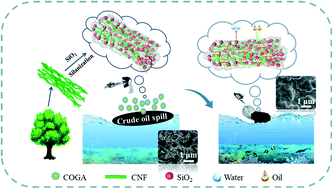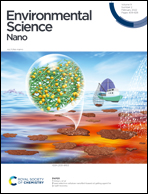Phase-selective cellulose nanofibril-based oil gelling agent for oil spill recovery†
Abstract
In this study, a novel type of powdery bio-based oil gelling agent was successfully developed for oil spill recovery. To lock the oil phase, environment-friendly natural cellulose nanofibrils (CNFs) were used to form 3D networks, and SiO2 nanoparticles were introduced to increase the surface roughness and pore volume. Unlike previously reported phase-selective organic gelators (PSOGs), this novel oil gelling agent does not require complex organic synthesis procedures and molecular framework design. Resulting from the surface hydrophobicity, network structure and capillary action, the CNF-based oil gelling agent (COGA) can solidify a variety of oil phases (diesel, kerosene, crude oil etc.) efficiently from oil–water biphasic mixtures to form stable solids, which is essential for subsequent oil spill recovery. Importantly, external conditions such as temperature and water quality have little impact on its oil solidification performance. Simultaneously, the oil solidified by COGA shows ultra-high mechanical strength (yield stress > 3000 Pa) and thermal stability. In conclusion, based on the green and sustainable CNF, the developed novel COGA material shows excellent solidification performance, good biocompatibility and simple synthesis condition, and demonstrates great potential in the oil spill recovery.

- This article is part of the themed collection: Environmental Science: Nano Recent HOT Articles


 Please wait while we load your content...
Please wait while we load your content...